-
FRIEZE Los Angeles
-
-

-
-
-
-
-
-
-
-
-

-
-
-

-

Material tactility, its possibilities, limitations, and transformation form the core of Kelly Akashi's practice. Often using her own hands as a subject, the artist captures momentary gestures, casting them into perpetual existence. Drawing attention to the fluidity and interconnectedness of the media she uses, Akashi aims to capture the tension and physicality of objects in her practice.
In this work Akashi uses found calcite, a polymorph of calcium carbonate. Interested in polymorphism (the ability of a special decimal composition to crystallize in more than one form), Akashi uses this "hybrid” structure to draw a parallel to her own hybrid cultural background. In Life Forms (Polymorph), she is using a language of polymorph geology to refer to both life forms (the calcite and the human) inhabiting multiple states at once.
Upcoming, Kelly Akashi will have a major solo exhibition at the San Jose Museum of art in September 2022.

Kelly AKASHI
Life Forms (Polymorph)
2022
Calcite, lost-wax cast lead crystal
7 1/4 x 12 3/4 x 3 3/4 inches; 18.4 x 32.4 x 9.5 cm

This wall-mounted work by 2011 Turner Prize Winner Martin Boyce continues the artist's series of pieces cast from jesmonite, featuring wood-grain patterns that resemble modernist architectural fragments. These linear patterns serve as background for a wall-mounted telephone with curling cables that sweep across the panel. Raised steel text, taken from Boyce’s iconic typography based on the concrete tree motif presented by the Martel brothers in 1925, seems to float in the sky seen through a window. He examines the phone’s territorial relationship as a portal between two fixed points in space and time, as well as their battle against their own obsolescence. This piece is characteristic of Boyce's work that engages with thresholds and transformation, the titlesuggesting the intersection of natural phenomena and man-made interventions.
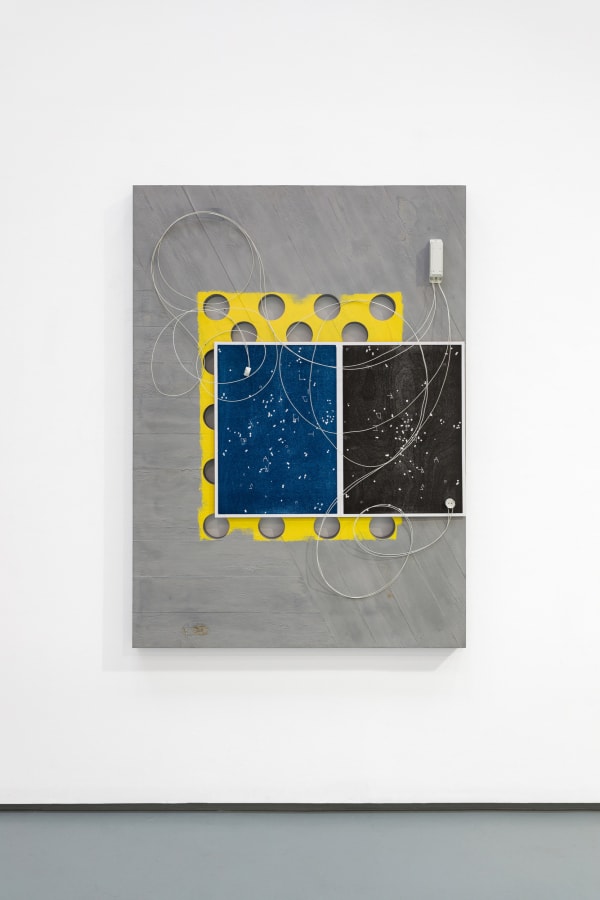
Martin BOYCE
Drilled Into the Night Sky
2021
Jesmonite, wood block print, plywood, painted bronze wire, cellulose paint on cast bronze and bronze wire
61 x 43 1/2 x 9 7/8 inches; 155.5 x 110.5 x 25 cm

Since the early 1990s, Sandra Cinto has developed a rich vocabulary of symbols and lines to create lyrical landscapes and narratives that hover between fantasy and reality. Using drawing as her point of departure, the artist renders intricate and mesmerizing seascapes, rainstorms, and celestial skies that frequently engage with the surrounding architecture to create seemingly weightless, immersive environments. Evoking stories of human hardship and redemption, Cinto's fantastical imagery serves as a metaphor for the human odyssey, while also pushing the limits and possibilities of drawing.

Sandra CINTO
Untitled
2022
Acrylic on canvas
65 x 86 5/8 inches; 165 x 220 cm


Geometrically speaking, a rainbow is actually a circle that only appears to be an arch because of the horizon line. If the earth did not block our view of the rainbow, it would appear as a full ring – much like the subject of these paintings. Each of the canvases features a circular band of colours that progresses from red through orange and yellow to green, blue, and indigo – the tones that make up the prismatic spectrum. In contrast to the black background that dominates the majority of the circular canvases, the circular rainbows, like the ephemeral phenomenon that inspired them, seem almost to be made of light.

Olafur ELIASSON
Colour experiment no. 102
2021
Oil on canvas
78 3/4 x 78 3/4 inches; 200 x 200 cm

The last square sphere is an excellent example of Eliasson’s long interest in geometry, light and perception. The work is made up of a complex pattern of pentagons, squares, triangles and rhombi, linked together and surrounding the inner glass surface. These shapes emphasize the framework’s depth and allow the viewer to peer into the core of the structure. As the light in the center passes through color-effect filter glass panels it casts kaleidoscopic shadows on all of the surrounding surfaces, creating an immersive environment.

Olafur ELIASSON
The last square sphere
2009
Stainless steel, color effect filter glass, bulb
27 1/2 x 27 1/2 x 27 1/2 inches; 70 x 70 x 70 cm
Edition of 10; 2 APs

Untitled (Spoken poem) is based on poets from around the world who have been imprisoned for their words. For centuries, language has always been a key tool of political power and control, however this systemic hijacking of language for political goals has been consistently countered by poets who have exploited language's subversive potential to counter state-driven narratives. However, the result of taking a stance against the state and its use of language for profiling, segregating and creating hierarchies, has meant imprisonment and persecution to poets across history. In this work, Gupta has spoken each poem into a jar, sealed and labeled it - an attempt to unlock their imprisoned voices.

Shilpa Gupta
Untitled (Spoken Poem in a Bottle)
2018
Bottle, vitrine, bulb
64 x 13 x 18 inches; 162.6 x 33 x 45.7 cm
Edition of 5

Laura Lima’s continuously changing ‘Leviane’ works consist of transparent fabric and dry ice. Engaging with concepts of gravity and density, fragments of dry ice slowly evaporate from the pores of these lightweight fiber constructions. Referencing the history of landscape painting, Lima uses the smoke as a painting tool to blur the color and details of the pieces, creating shadows akin to how one creates painterly atmospheric qualities. Chemically and physically, traditional oil paintings change very slowly over time. Accelerating this concept, Lima’s use of dry ice creates an immediate transition of materials, cycling through existence and dispersion as the ice melts and is repeatedly replenished. In a domestic setting, the dry ice is optional and can be added as frequently as desired.
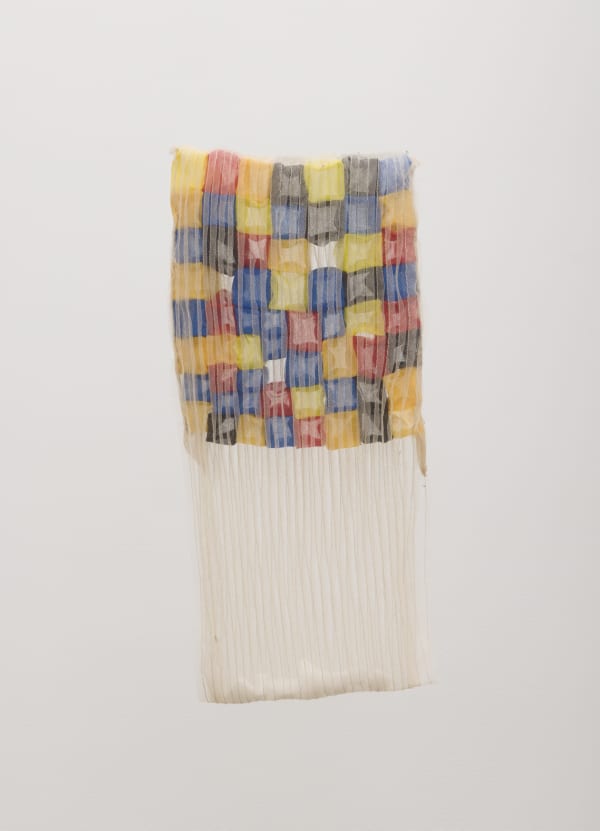
Laura Lima
Levianes #7
2021
Tulle and dry ice
19 x 9 x 2 inches; 48.3 x 22.9 x 5.1 cm

Remarkable in execution and detail, Landscape Fragment was created within an intimate logic that has now become signature to Manders' practice. The work appears to be soft clay mid-way through the process of becoming a sculpture. The artist freezes a very specific moment in time, highlighting the fragility of every moment that passes. The manipulation of material generates a sense of puzzlement and awe, masterfully creating a sense of timelessness— while the sculpture seems to be just made, it is at the same time enigmatically atemporal.
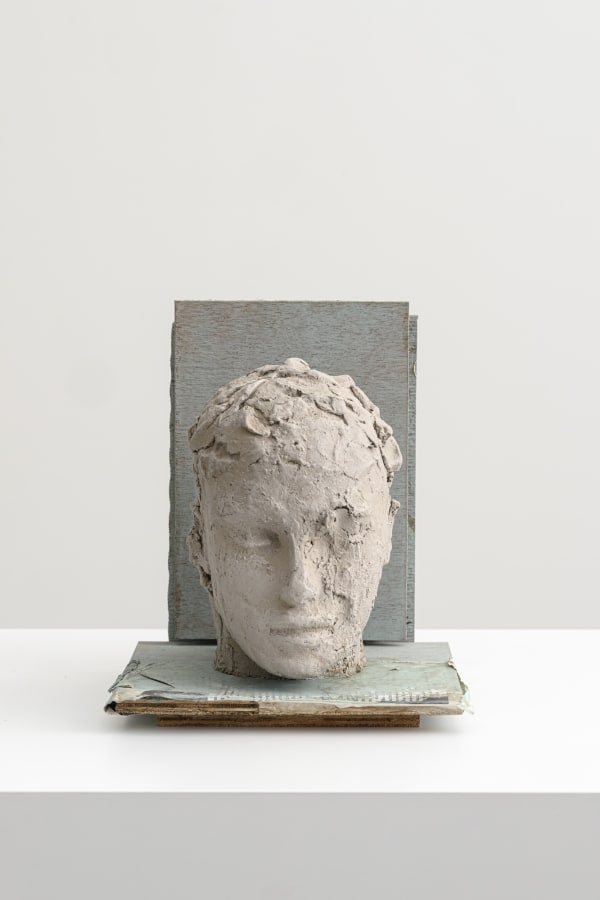
Mark MANDERS
Landscape Fragment
2021-22
Painted bronze, painted wood, offset print on paper
8 1/4 x 7 1/2 x 7 1/2 inches; 21 x 19 x 19 cm
Edition of 3, AP

Wild Flowers of Palestine demonstrates Oppenheim’s unique ability to translate historical subjects and early methods of photo-making via contemporary experimental darkroom processes. In this new series, the artist explores stereoscopy in particular, a technique popular in the late 19th and early 20th centuries for its pseudo-3D effect, created by simultaneously presenting two images of the same object taken at slightly different angles. In this project, Oppenheim combines both halves of a stereoscopic negative, intentionally misaligning the images to create a new double image not visible in the original stereographic views. Known for embracing flaws that arise during the developing process, Oppenheim employs the imperfections latent in many of the original stereoscopic pairs and allows new compositions to emerge through their double exposure.
Wild Flowers' source material derives from the image archive of the American Colony in Jerusalem, now housed in the Library of Congress Collection. The American Colony exists today as an international hotel frequented by journalists, diplomats and UN officials alike given it’s neutral status outside of the turbulent politics of the land. The 20,000+ images taken by the Colony members of places and events in the region from the end of the 19th century included a small group of wildflowers, from which Oppenheim created photo negatives using the archive's digital files. Wild Flowers further highlights Oppenheim’s ability to collapse time and give otherwise forgotten images a material present.
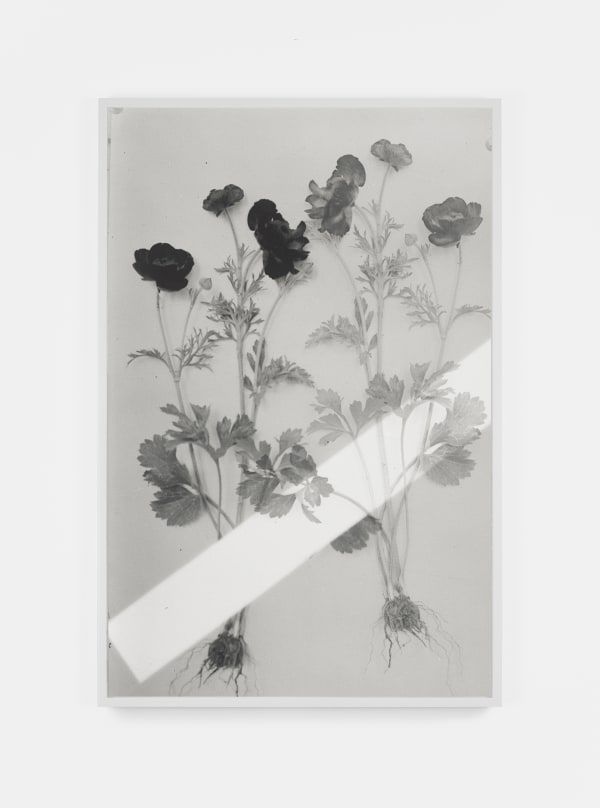
Lisa Oppenheim
Red Ranunculus, 1900/2019 (Version III)
2019
Unique silver gelatin print
35 x 23 inches; 89 x 58.5 cm (unframed)
35 3/4 x 23 3/4 x 1 1/2 inches; 90.8 x 60.3 x 3.8 cm (framed)


Analia Saban dissects and reconfigures traditional notions of painting, often using the medium of paint as the subject itself. This body of work continues Saban's investigations into the relationship between paint, pigment and canvas. In this work, thin layers of dried acrylic paint is woven through the linen, physically embedded into the fabric of the painting. Resembling a classic pie chart, this work addresses our society’s obsession with statistics. Heightened over the last few years, we have become even more consumed with measuring, quantifying and categorizing. The circular motif also makes reference to geometry and its importance throughout art history.
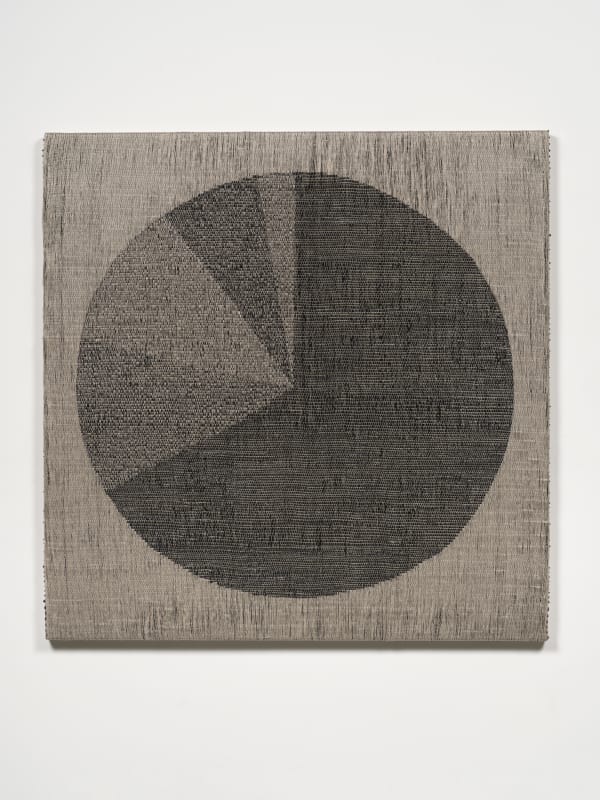
Analia Saban
Pie Chart (3%, 8%, 11%, 11%, 67%)
2022
Woven acrylic paint and linen thread on panel
71 1/4 x 71 x 1 1/4 inches; 181 x 180.3 x 3.2 cm

Among the leading German artists of his generation, Thomas Scheibitz has developed his own conceptual language that bridges the realms of figuration and abstraction, at times dissolving them entirely. Drawing from classical painting and architecture, the contemporary urban landscape, and popular culture, Scheibitz deconstructs and recombines signs, images, shapes, and architectural fragments in ways that challenge traditional contexts and interpretations. While centrally concerned with principles of classification and systems of order, the artist’s paintings, sculptures and works on paper resist traditional categorization.
Donald and Palace have both been used as titles for previous works by the artist. Both motifs are composed here in a way that looks reminiscent of a double exposure. Of course an obvious link may be drawn to current day US politics, however this was coincidental.
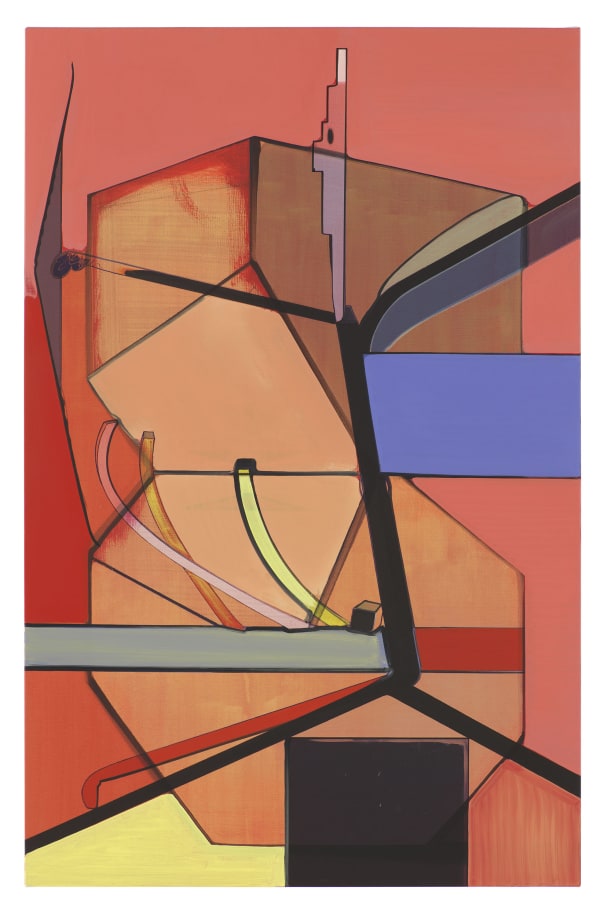
Thomas SCHEIBITZ
Donald and Palace
2020
Oil, vinyl and pigment marker on canvas
55 1/8 x 35 3/8 x 1 1/8 inches; 140 x 90 x 3 cm


bytu 11.09 HM connects the consciousness of breath and its physical presence. Ibytu means the wind, the breath of the earth - in Guaraní. For Saraceno, this entanglement of breath and spirit filling and forming these glass shapes also helps to consider both the inequalities of breath in the world but also the myriad languages and traditions in which breath and life are inextricably intertwined.
Tómas Saraceno has a current solo exhibition at Tanya Bonadkar Gallery, New York.
Saraceno also has a major solo exhibition on view at The Shed, New York through April 17, 2022.

Tomás SARACENO
Ibytu 11.09 HM
2022
Hand blown partially mirrored glass, polyester rope
3 modules: 15 x 15 3/4 x 15 inches; 38 x 40 x 38 cm
2 modules: 10 5/8 x 15 x 8 5/8 inches; 27 x 38 x 22 cm


Haim Steinbach's new work at hand brings together three different types of found objects and presents them on the triangular, laminated plywood shelf that is the hallmark of his sculptural practice. These objects—a pair of Gripmaster hand strengtheners, a Cinnamon Toast Crunch cereal box, and two "KONG" chew toys—are everyday items that are commercially produced, widely available, and have a functional use. Like Marcel Duchamp's readymade, however, Steinbach has elevated these objects, placing them in the context of artistic display. In this new milieu, viewers are invited to consider the objects' formal properties and the variety of meanings their combination may suggest.
The formal elements of the work are immediately striking, with rich colors and repeating shapes and numerical coincidences that create formal linkages between the work’s seemingly disparate elements. However, the objects are not only abstract forms, because they remain recognizable as everyday, functional objects. The cereal box dominates the composition because of its central placement and striking anthropomorphized form, acting visually like an icon, but at the same time, it is a typical mass market cereal, whimsical and prosaic. The other sides of the box contain a jumble of colors, images, and text whose purpose is to entice potential customers through their visual appeal. The sinuous, ergonomic shapes of the pairs of Kongs and Gripmasters likewise perform a dual role, combining function and aesthetics.
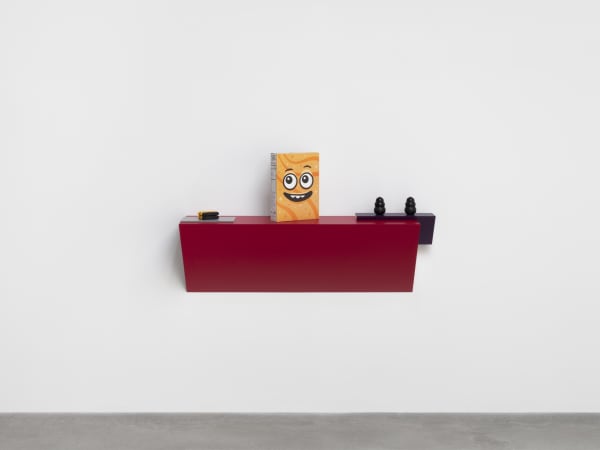
Haim STEINBACH
at hand
2021
Plastic laminated wood shelf; 2 plastic and metal hand grip strengtheners; cardboard cereal box; 2 rubber dog chews
27 1/2 x 47 1/4 x 12 1/2 inches; 69.9 x 120 x 31.8 cm

Through complex constellations of objects and a proliferation of images, Sze expands upon the never- ending stream of visual narratives that we negotiate daily, from magazines and newspapers, television and iPhones, to cyberspace and outer space. This work evoke the generative and recursive process of image-making in a world where consumption and production are more interdependent, where the beginning of one idea is the ending of another— and where sculpture gives rise to images, and images to sculpture. Sze expands her work by embedding her nuanced sculptural language into the material surfaces of painting and into the digital realm—collapsing distinctions between two, three and four dimensions. Her practice fundamentally alters our sense of time, place, and memory by transforming our experiences of the physical world around us.

Sarah SZE
Blue Aperture
2022
Oil paint, acrylic paint, acrylic polymers, ink, aluminum, diabond and wood
16 x 20 x 1 1/2 inches; 40.6 x 50.8 x 3.8 cm


Interested in language and its inevitable abstraction, Lisa Williamson leans into the formal considerations of sculpture to create works that are visually precise, physically resonant, and often attune to the spaces in which they are exhibited. The artist’s idiosyncratic practice follows a logic that is associative; compressing internal experience into forms that are both tangible and resistant at once. While there is a significant level of reduction and abstraction throughout the artist’s work, aspects of architecture, landscape and the figure remain visible throughout.
With a unique approach to scale and proportion, in which the artist uses her own body or the surrounding environment as a measuring device, there is a particular balance and formal terseness integral to each form. Regarding precision as an expressive gesture and calibration as a mode of production, the artist’s distinct approach to color and meticulous attention to surface softens the line between painting and sculpture, landscape and portraiture, language and object.
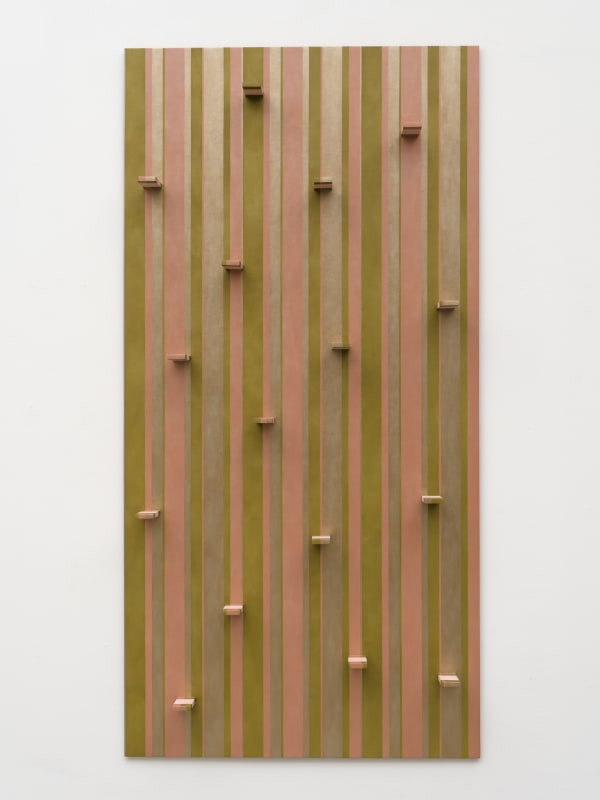
Lisa Williamson
Dive
2022
Flashe on primed aluminum
80 x 40 x 6 3/4 inches; 203.2 x 101.6 x 17.1 cm